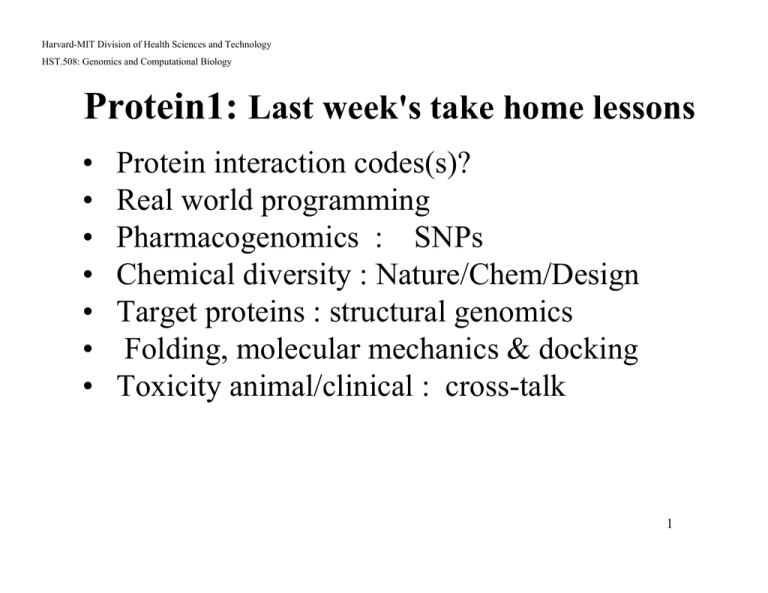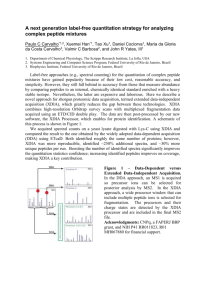Protein1: Last week's take home lessons
advertisement

Harvard-MIT Division of Health Sciences and Technology
HST.508: Genomics and Computational Biology
Protein1: Last week's take home lessons
•
•
•
•
•
•
•
Protein interaction codes(s)?
Real world programming
Pharmacogenomics : SNPs
Chemical diversity : Nature/Chem/Design
Target proteins : structural genomics
Folding, molecular mechanics & docking
Toxicity animal/clinical : cross-talk
1
Protein2: Today's story & goals
• Separation of proteins & peptides
• Protein localization & complexes
• Peptide identification (MS/MS)
– Database searching & sequencing.
• Protein quantitation
– Absolute & relative
• Protein modifications & crosslinking
• Protein - metabolite quantitation
2
Why purify?
• Reduce one source of noise
(in identification/quantitation)
• Prepare materials for in vitro experiments
(sufficient causes)
• Discover biochemical properties 3
(Protein) Purification Methods
• Charge: ion-exchange chromatography, isoelectric focusing
• Size: dialysis, gel-filtration chromatography, gel-electrophoresis, sedimentation velocity
• Solubility: salting out
• Hydrophobicity: Reverse phase chromatography
• Specific binding: affinity chromatography
• Complexes: Immune precipitation (± crosslinking)
• Density: sedimentation equilibrium
4
Protein Separation by Gel Electrophoresis
• Separated by mass: Sodium dodecyl sulfate (SDS) polyacrylamide gel electrophoresis.
– Sensitivity: 0.02ug protein with a silver stain.
– Resolution: 2% mass difference.
• Separated by isoelectric point (pI): polyampholytes pH gradient gel.
– Resolution: 0.01 pI.
5
Comparison of predicted with observed protein
properties (localization, postsynthetic
modifications)
E.coli
See Link et al. 1997 Electrophoresis 18:1259-313 (Pub) (http://www.ncbi.nlm.nih.gov/entrez/query.fcgi?cmd=Retrieve&db=PubMed&list_uids=9298646&dopt=Abstract)
6
Computationally checking proteomic data
Property
Basis of calculation
Protein charge RKHYCDE (N,C), pKa, pH (Pub)
(http://gcg.nhri.org.tw/isoelectric.html#algorithm)
Protein mass
Peptide mass
Peptide LC
Subcellular
Expression
Calibrate with knowns (complexes)
Isotope sum (incl.modifications)
aa composition linear regression
Hydrophobicity, motifs (Pub)
Codon Adaptation Index (CAI)
7
Protein2: Today's story & goals
• Separation of proteins & peptides
• Protein localization & complexes
• Peptide identification (MS/MS)
– Database searching & sequencing.
• Protein quantitation
– Absolute & relative
• Protein modifications & crosslinking
• Protein - metabolite quantitation
8
Cell fraction: Periplasm
2D gel: SDS mobility isoelectic pH
See Link et al. 1997 Electrophoresis 18:1259-313
(Pub)
(http://www.ncbi.nlm.nih.gov/entrez/query.fcgi?cmd=Retrieve&db=PubMed&list_uids=9298646&dopt=Abstract)
9
Cell localization predictions
TargetP: using N-terminal sequence discriminates mitochondrion,
chloroplast, secretion, & "other" localizations with a success rate of
85%. (pub) (http://www.cbs.dtu.dk/services/TargetP/),
(http://www.ncbi.nlm.nih.gov/entrez/query.fcgi?cmd=Retrieve&db=PubMed&list_uids=10891285&dopt=Abstract)
Gromiha 1999, Protein Eng 12:557-61. A simple method for
predicting transmembrane alpha helices with better accuracy. (pub)
(http://www.ncbi.nlm.nih.gov/entrez/query.fcgi?cmd=Retrieve&db=PubMed&list_uids=10436081&dopt=Abstract)
Using the information from the topology of 70 membrane proteins...
correctly identifies 295 transmembrane helical segments in 70
membrane proteins with only two overpredictions.
10
Isotope calculations
Mass resolution 0.1% vs.
Symbol
-----H(1)
C(12)
N(14)
O(16)
S(32)
Mass
---------1.007825
12.000000
14.003074
15.994915
31.972072
1 ppm
Abund.
-----99.99
98.90
99.63
99.76
95.02
Symbol
-----H(2)
C(13)
N(15)
O(17)
S(33)
Mass
----------2.014102
13.003355
15.000109
16.999131
32.971459
Abund.
------0.015
1.10
0.37
0.038
0.75
11
Computationally checking proteomic data
Property
Basis of calculation
Protein charge RKHYCDE (N,C), pKa, pH (Pub)
(http://gcg.nhri.org.tw/isoelectric.html#algorithm)
Protein mass
Peptide mass
Peptide LC
Subcellular
Expression
Calibrate with knowns (complexes)
Isotope sum (incl.modifications)
aa composition linear regression
Hydrophobicity, motifs (Pub)
Codon Adaptation Index (CAI)
12
trypsin
High
Performance
Liquid
Chromatography
13
Mobile Phase of HPLC
• The interaction between the mobile phase
and sample determine the migration speed.
– Isocratic elution: constant migration speed in
the column.
– Gradient elution: gradient migration speed in
the column.
14
Stationary Phase of HPLC
• The degree of interaction with samples
determines the migration speed.
–
–
–
–
–
–
–
Liquid-Solid: polarity.
Liquid-Liquid: polarity.
Size-Exclusion: porous beads.
Normal Phase: hydrophilicity and lipophilicity.
Reverse Phase: hydrophilicity and lipophilicity.
Ion Exchange.
Affinity: specific affinity.
15
See
Sereda, T. et al. “Effect of the α-amino group on peptide retention behaviour in reversedphase chromatography.
Wilce, et al. “High-performance liquid chromatography of amino acids, peptides and
proteins.” Journal of Chromatography, 632 (1993) 11-18.
16
A Map is Like a 2D Peptide Gel
First Dimension:
Reverse Phase Chromatography Separation By Hydrophobicity
R
A P
S
V
MW
C
A
G F
L
E
K
Q
G
RT
min
C
C
T
K
D
m/z
Second Dimension:
Mass Spectrometry
Separation by Mass
17
What Information Can Be Extracted From A Single Peptide Peak
abundance
Isotopic Variants of
DAFLGSFLYEYSR
rt
m/z
abundance
@ 36.418 min
0 X 13C
1 X 13C
2 X 13C
3 X 13C
K.Leptos 2001
18
m/z
Directed Analysis of
Large Protein
Complexes
by 2D separation:
strong cation exchange
and reversed-phased
liquid chromatography.
Link, et al. 1999, Nature Biotech. 17:676-
82. (Pub)
(http://www.ncbi.nlm.nih.gov/entrez/query.fcgi?cmd=Retrieve&db=PubMed&list_ui
ds=10404161&dopt=Abstract)
19
A new 40S subunit
protein
See Link AJ, et al., Nat Biotechnol. 1999 Jul;17(7):676-82. Direct
analysis of protein complexes using mass spectrometry.
20
Protein2: Today's story & goals
• Separation of proteins & peptides
• Protein localization & complexes
• Peptide identification (MS/MS)
– Database searching & sequencing.
• Protein quantitation
– Absolute & relative
• Protein modifications & crosslinking
• Protein - metabolite quantitation
21
Tandem Mass Spectrometry
See Siuzdak, Gary. “The emergence of mass spectrometry in biochemical research.” Proc. Natl. Acad. Sci. 1994, 91, 11290-11297.
Roepstorff, P.; Fohlman, J. Biomed. Mass Spectrom. 1994, 11, 601.
Quadrople Q1 scans or selects m/z. Q2 transmits those ions through collision gas (Ar).
Q3 Analyzes the resulting fragment ions.
22
Ions
24
Peptide Fragmentation and Ionization
25
Tandem Mass Spectra Analysis
See Gygi et al. Mol. Cell Bio. (1999)
26
Mass Spectrum Interpretation Challenge
• It is unknown whether an ion is a b-ion or an y-ion
or else.
• Some ions are missing.
• Each ion has multiple of isotopic forms.
• Other ions (a or z) may appear.
• Some ions may lose a water or an ammonia.
• Noise.
• Amino acid modifications.
27
A dynamic programming approach to de novo peptide sequencing via tandem mass spectrometry
See Chen et al 2000. 11th Annual ACM-SIAM Symp. of
Discrete Algorithms pp. 389-398.
28
SEQUEST: Sequence-Spectrum Correlation
Given a raw tandem mass spectrum and a
protein sequence database.
• For every protein in the database,
• For every subsequence of this protein
–
–
Construct a hypothetical tandem mass spectrum
Overlap two spectra and compute the correlation coefficient (CC).
• Report the proteins in the order of CC score.
Eng, et al. 1994, Amer. Soc. for Mass Spect. 5: 976-989 (Sequest)
29
(http://thompson.mbt.washington.edu/sequest/)
Protein2: Today's story & goals
• Separation of proteins & peptides
• Protein localization & complexes
• Peptide identification (MS/MS)
– Database searching & sequencing.
• Protein quantitation
– Absolute & relative
• Protein modifications & crosslinking
• Protein - metabolite quantitation
30
Expression quantitation methods
RNA
Protein
Genes immobilized labeled RNA
RNAs immobilized labeled genesNorthern gel blot
QRT-PCR
Reporter constructs
Fluorescent In Situ (Hybridization)
Tag counting (SAGE)
Differential display
Antibody arrays
Westerns
-nonesame
same (Antibodies)
-nonemass spec
31
Molecules per cell
E.coli/yeast
Human
Individual mRNAs:
10-4 to 105
10-1 to 103
Proteins:
10 to 106
10-1 to 108
32
MS Protein quantitation R=.84
Yeast Protein ESI-MS Quantitation
10000
Day 2 Measure
1000
y = 0.8754x + 0.1573
R2 = 0.8381
100
10
1
0.1
0.1
Link, et al
1
10
100
1000
Day 1 measure
33
MS quantitation reproducibility
Sample: Angiotensin, Neurotensin, Bradykinin
Map: 600 – 700 m/z
Coefficients of Variance
CV = σ/µ
5
3
2
1
CV
28
0.
26
0.
24
0.
22
0.
2
0.
18
0.
16
0.
4
0
.
1
12
0.
1
0.
08
0.
6
0
.
0
04
0.
0.
02
0
0
Frequency
4
34
Correlation between protein and mRNA abundance in yeast
See Gygi et al. 1999, Mol. Cell Biol. 19:1720-30 (Pub)
(http://www.ncbi.nlm.nih.gov/entrez/query.fcgi?cmd=Retrieve&db=PubMed&list_uids=10022859&dopt=Abstract)
35
Normality tests
See Weiss 5th ed. Page 920.
Types of non-normality: kurtosis, skewness (www)
(log) transformations to normal. (http://www.marketminer.com/prophet/statguide/n-dist_exam_res.html)
Futcher et al 1999, A sampling of the yeast proteome. Mol.Cell.Biol.
19:7357-7368. (Pub) (http://mcb.asm.org/cgi/content/full/19/11/7357?view=full&pmid=10523624)
36
Spearman correlation rank test
rs = 1 - {6S/(n3-n)}
Rank (from 1 to n, where n is the number of pairs of data) the
numbers in each column. If there are ties within a column , then
assign all the measurements that tie the same median rank.
Note, avoids ties (which reduce the power of the test) by
measuring with as fine a scale as possible. S= sum of the square
differences in rank. (ref) (http://www.wisc.edu/ecology/labs/phenology/spearman.html)
X Y Rx Ry
1 8 1 4
6 2 3 1
6 3 3 2
n=4 6 4 3 3
37
Correlation of (phosphorimager 35S met) protein & mRNA rp = 0.76 for log(adjusted RNA) to log(protein)
rs = .74 overall; 0.62 for the top 33 proteins & 0.56 (not
significantly different) for the bottom 33 proteins
38
Observed (Phosphorimage) protein levels vs. Codon Adaptation Index (CAI)
Codon Adaptation Index (CAI) Sharp and Li (1987); fi is the relative
frequency of codon i in the coding sequence, and Wi the ratio of the
frequency of codon i to the frequency of the major codon for the same
amino-acid.
ln(CAI)= Σ fi ln (Wi)
i=1,61
39
ICAT Strategy for Quantifying Differential Protein Expression.
X= H or D
See Gygi et al. Nature Biotechnology (1999)
40
Mass Spectrum and
Reconstructed Ion Chromatograms.
See Gygi et al. Nature Biotechnology (1999)
41
Protein & mRNA Ratios +/- Galactose
See Ideker et al 2001
(http://arep.med.harvard.edu/pdf/Ideker01.pdf)
42
Protein2: Today's story & goals
• Separation of proteins & peptides
• Protein localization & complexes
• Peptide identification (MS/MS)
– Database searching & sequencing.
• Protein quantitation
– Absolute & relative
• Protein modifications & crosslinking
• Protein - metabolite quantitation
43
Post-synthetic modifications
• Radioisotopic labeling: PO4 S,T,Y,H
• Affinity selection:
Cys: ICAT biotin-avidin selection
PO4: immobilized metal Ga(III) affinity chromatography(IMAC)
(http://www.ncbi.nlm.nih.gov/entrez/query.fcgi?cmd=Retrieve&db=PubMed&list_uids=10424175&dopt=Abstract)
Specific PO4 Antibodies
Lectins for carbohydrates
• Mass spectrometry
44
32P labeled phoshoproteomics
Low abundance cell cycle proteins not detected above
background from abundant proteins
See Futcher et al 1999, A sampling of the yeast proteome.
Mol.Cell.Biol. 19:7357-7368. (Pub)
(http://mcb.asm.org/cgi/content/full/19/11/7357?view=full&pmid=10523624)
45
Natural crosslinks
Disulfides
Collagen
Ubiquitin
Fibrin
Glycation
Adeno primer proteins
Cys-Cys
Lys-Lys
C-term-Lys
Gln-Lys
Glucose-Lys
dCMP-Ser
46
Crosslinked peptide Matrix-assisted laser
desorption ionization Post-Source Decay
(MALDI-PSD-MS)
tryptic digest of BS3 cross-linked
FGF-2. Cross-linked peptides are
identified by using the program
ASAP and are denoted with an
asterisk (9). (B) MALDI-PSD
spectrum of cross-linked peptide E45­
R60 (M + H+ = m/z 2059.08).
47
Constraints
for homology modeling based on MS
crosslinking distances
The 15 nonlocal throughspace distance constraints generated by the
chemical cross-links (yellow dashed lines) superimposed on the average
NMR structure of FGF-2 (1BLA). The 14 lysines of FGF-2 are shown in
red.
See Young et al 2000, PNAS 97: 5802 (Pub)
(http://www.pnas.org/cgi/content/full/97/11/5802)
48
Homology modeling accuracy
100
% sequence identity
90
80
70
Series1
60
50
40
30
20
1
1.5
2
2.5
3
3.5
4
Swiss-model RMSD of the test set in Angstroms
49
(http://www.expasy.ch/swissmod/SM_LikelyPrecision.html)
Top 20 threading models for FGF ranked by crosslinking constraint error
See Young et al. PNAS | May 23, 2000 | vol. 97 | no. 11 | 5802-5806
http://www.pnas.org/cgi/content/full/97/11/5802
50
Protein2: Today's story & goals
• Separation of proteins & peptides
• Protein localization & complexes
• Peptide identification (MS/MS)
– Database searching & sequencing.
• Protein quantitation
– Absolute & relative
• Protein modifications & crosslinking
• Protein - metabolite quantitation
51
Challenges for accurately measuring metabolites
• Rapid kinetics
• Rapid changes during isolation
• Idiosyncratic detection methods:
enzyme-linked, GC, LC, NMR
(albeit fewer molecular types than RNA& protein)
52
1634 Metabolite Masses
256 amino acids
600
Y=
400
Frequency
598 have identical mass
e.g. Ile & Leu = 131.17
200
0
Databases
160 240
80
320
560 800 1040 1280 1520
X = Mass
Karp et al. (1998) NAR 26:50. EcoCyc; Selkov, et al. (1997) NAR 25:37. WIT
Ogata et al. (1998) Biosystems 47:119-128 KEGG
53
Y=
RP
LC
retention
time
in min.
I
L
(higher
hydro­
phocity)
W
X = Mass
54
Metabolite fragmentation & stable isotope labeling
See Wunschel J Chromatogr A 1997, 776:205-19 Quantitative analysis of neutral & acidic sugars in whole bacterial cell hydrolysates using high-performance anion-exchange LC-ESI-MS2.
(Pub)
(http://www.ncbi.nlm.nih.gov/entrez/query.fcgi?cmd=Retrieve&db=PubMed&list_uids=9291597&dopt=Abstract)
55
Isotopomers
See Klapa et al. Biotechnol Bioeng 1999; 62:375. Metabolite and
isotopomer balancing in the analysis of metabolic cycles: I. Theory.
(Pub) "accounting for the contribution of all pathways to label
distribution is required, especially ... multiple turns of metabolic
cycles... 13C (or 14C) labeled substrates.“
(http://www.ncbi.nlm.nih.gov/entrez/query.fcgi?cmd=Retrieve&db=PubMed&list_uids=10099550&dopt=Abstract)
56
MetaFoR: Metabolic Flux Ratios Fractional 13C labeling > Quantitative 2D NMR
Why use amino acids from proteins rather than metabolites directly?
See:
Sauer J et al. Bacteriol 1999;181:6679-88 (Pub)
(http://www.ncbi.nlm.nih.gov/entrez/query.fcgi?cmd=Retrieve&db=PubMed&list_uids=10542169&dopt=Abstract)
Szyperski et al 1999 Metab. Eng. 1:189.
(http://www.biotech.biol.ethz.ch/sauer/pdf/1999 - Uwe Sauer Metabol Eng.pdf)
Dauner et al. 2001 Biotec Bioeng 76:144
(http\www.biotech.biol.ethz.ch\sauer\pdf\2001 - Michael Dauner et al B&B.pdf)
57
A functional genomics strategy that uses metabolome data to reveal the phenotype of silent mutations
See Raamsdonk et al. 2001 Nature Biotech 19:45.
(http://arep.med.harvard.edu/pdf/Raamsdonk01.pdf)
58
Types of interaction models
Quantum Electrodynamics
Quantum mechanics
Molecular mechanics
Master equations
subatomic
electron clouds
spherical atoms
(101Pro1)
stochastic single molecules (Net1)
Phenomenological rates ODE
Flux Balance
Thermodynamic models
Steady State
Metabolic Control Analysis
Spatially inhomogenous models
Concentration & time (C,t)
dCik/dt optima steady state (Net1)
dCik/dt = 0 k reversible reactions
ΣdCik/dt = 0 (sum k reactions)
d(dCik/dt)/dCj (i = chem.species)
dCi/dx
Increasing scope, decreasing resolution
59
How do enzymes & substrates formally differ?
E
A
EA
ATP
E
EATP
EB
B
E2+P
ADP
EP
60
Catalysts increase the rate (&specificity) without being consumed.
Enzyme rate equations with one Substrate & one Product E
S
P
dP/dt = V (S/Ks - P/Kp)
1 + S/Ks + P/Kp
S
As P approaches 0:
dP/dt = V
1+ Ks/S
61
Enzyme Kinetic Expressions
Phosphofructokinase
vPFK
F 6
P PFK Mg
•
ATP
PFK
K Mg • ATP
K F 6 P
1 + F 6 P K PFK
1 + Mg •
ATP PFK
K Mg•
ATP
F 6 P
PFK
vmx
=
N PFK
4
N PFK =
1
+
L
PFK
0
4
ATPfree
Mg
1
+
PFK
1
+
PFK
K
ATP
K Mg
4
4
AMP
F 6P
1
+
PFK
1
+
PFK
K
K
AMP
F 6 P
Allosteric kinetic
parameters for
AMP, etc.
62
Human
Red Blood Cell
ODE model
ADP
ATP
ADP ATP
1,3 DPG
NADH
NAD
3PG
GA3P
2,3 DPG
FDP
2PG
DHAP
PEP
F6P
ADP
ATP
R5P GA3P F6P PYR
G6P
GLCe
ADP
ATP
GO6P
GLCi
ATP
ADP
2 GSH
GSSG
X5P S7P
ODE modelADO
e
INOe
2000 (Pub)
(http://atlas.med.harvard.edu/gmc/rbc.html)
GA3P
E4P
F6P
NADPH NADP
ADO
ADE
ADP
INO
IMP ATP
LACe
Cl-
HCO3-
PRPP
AMP
PRPP
HYPX
LACi
pH
AMP
ATP
Jamshidi et al.
NADH
NAD
RU5P
NADP
NADP
NADPH
NADPH
ADP +
K
Na+
GL6P
ATP
R1P
R5P
ADEe
63
Red Blood Cell in Mathematica
ODE model
Jamshidi et al.
2000 (Pub)
(http://atlas.med.harvard.edu/gmc/rbc.html)
64
Protein2: Today's story & goals
• Separation of proteins & peptides
• Protein localization & complexes
• Peptide identification (MS/MS)
– Database searching & sequencing.
• Protein quantitation
– Absolute & relative
• Protein modifications & crosslinking
• Protein - metabolite quantitation
65




